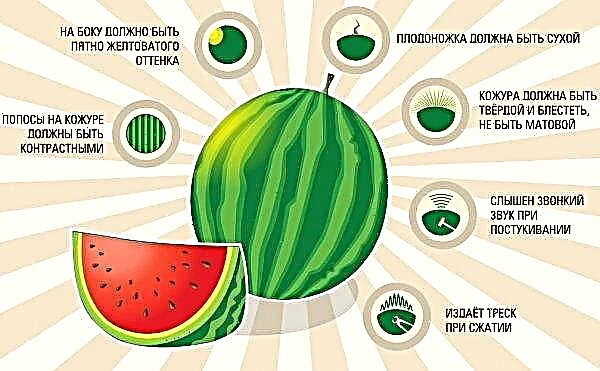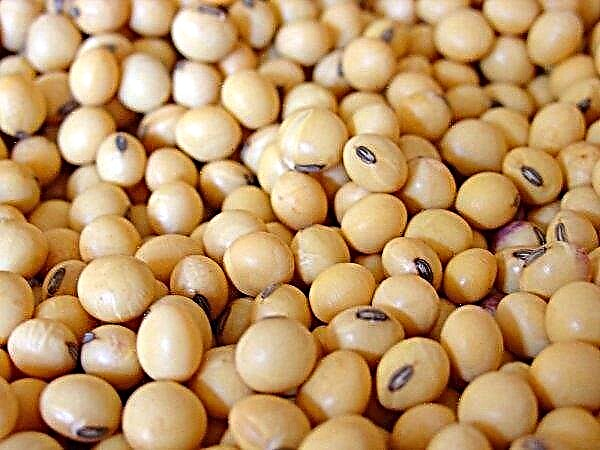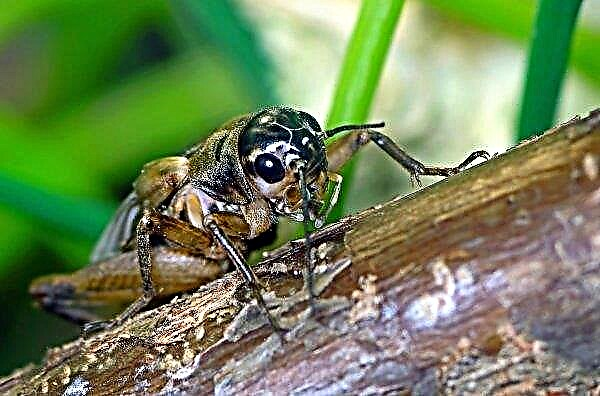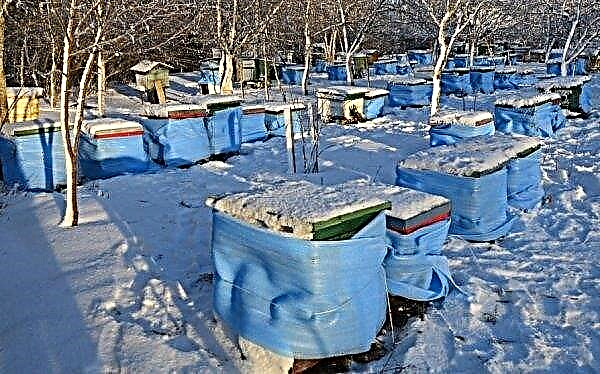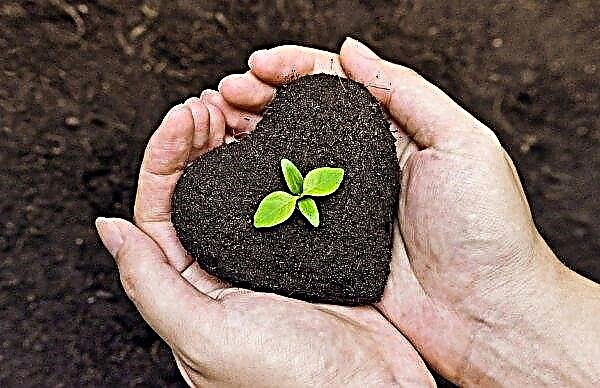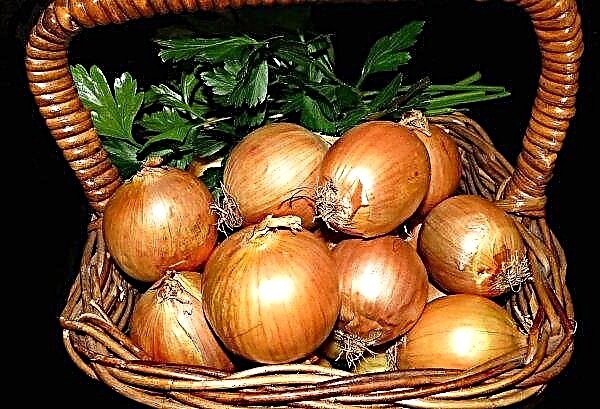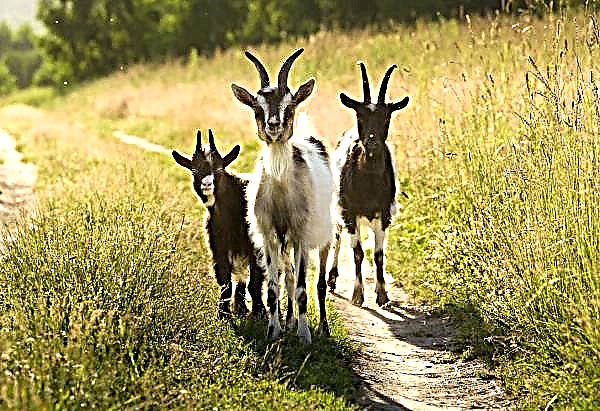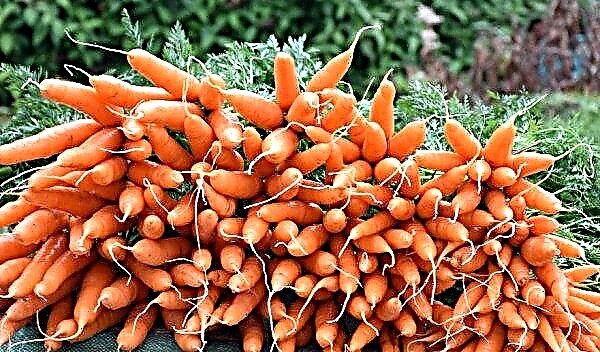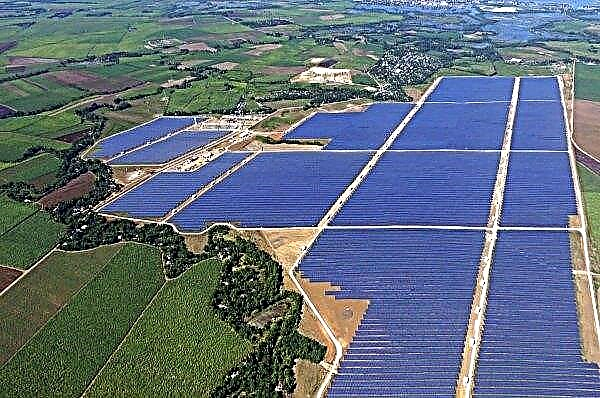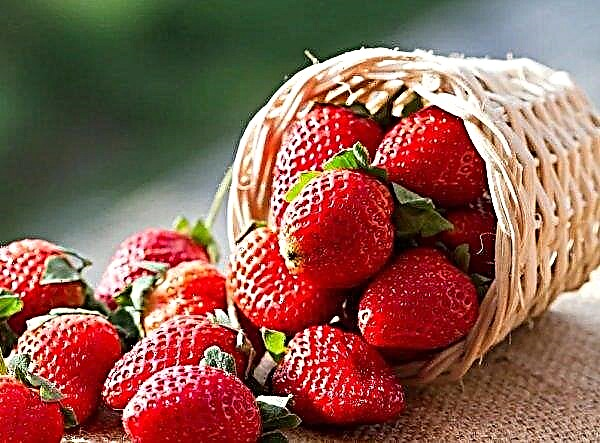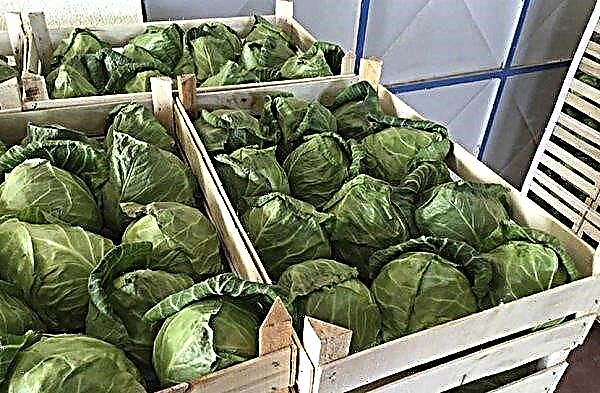When choosing tomatoes for growing, they are usually guided by yield and cost per unit of output. Variety "Spasskaya Tower" refers to varieties with high productivity. It is resistant to disease and does not require intensive care. Read about this variety and whether it is worth growing in this review.
Grade description
The tomato “Spasskaya Tower f1” was recently bred by breeders of Chelyabinsk. Belongs to mid-season semi-determinant varieties and can be successfully grown in a greenhouse and in open ground. Productivity in greenhouse cultivation increases by 25-30%. A great influence on the crop is provided by timely and proper watering. The height of the bushes is 1.5-2 m. To reduce the load on the trunk, tomatoes are tied to a trellis. The variety is high-yielding. Up to 10 brushes appear on 1 bush, each of which has 5-6 bright red tomatoes. The weight of one fetus can reach 0.5 kg. Productivity - 30 kg of fruits per 1 sq. M of area. The fruits are distinguished by excellent taste. The first tomatoes ripen on the day 95-115 after planting.
The variety is high-yielding. Up to 10 brushes appear on 1 bush, each of which has 5-6 bright red tomatoes. The weight of one fetus can reach 0.5 kg. Productivity - 30 kg of fruits per 1 sq. M of area. The fruits are distinguished by excellent taste. The first tomatoes ripen on the day 95-115 after planting.
Variety "Spasskaya tower f1" is characterized by the simultaneous ripening of most of the fruits. If tomatoes are grown for sale, then dense peel and good keeping quality are additional advantages of the variety.Did you know? More than 7500 varieties of tomatoes are grown in the world. Almost all of them are red, but there are yellow, green, orange, pink, black, brown, white and purple varieties.
One of the goals of creating a hybrid was to develop a variety that is resistant to adverse weather conditions and diseases. Therefore, the “Spassky Tower f1” can grow well in most regions and is almost not affected by disease. For personal use in salads, first and second courses, as well as in winter preparations.
Advantages and disadvantages
- Grade advantages:
- resistant to cool weather and diseases;
- can be grown both in the greenhouse and in the ground;
- high yielding;
- occupies a small area;
- ripening of the crop is quick and instant;
- excellent transportability and durability.
- Disadvantages varieties
- “Spasskaya tower f1” is a hybrid, therefore it is impossible to obtain high-quality tomato seeds in a normal field (cross-pollination of varieties by the wind affects);
- the need for tying due to the small root system and large mass of fruits.
Self-growing seedlings
To plant seeds for seedlings, you will need to prepare containers and soil for planting. Since tomato belongs to hybrid varieties, the seeds will have to be bought annually from the manufacturer. Before planting, they must be etched with a strong solution of potassium permanganate to prevent damage by rot, late blight and other fungal diseases.
Optimum timing for sowing
To correctly calculate the timing of planting seeds, accept for calculation the age of seedlings before planting in a permanent place. For the variety “Spasskaya Tower” it is 55-60 days. So, the seeds should be planted in pots in February, but at the beginning or at the end - choose based on where the tomatoes will grow: in the greenhouse or in the open ground.
The soil
The easiest way to grow seedlings is to take the soil from the garden and grow tomatoes in it. But do not forget to conduct a test to determine its acidity.
Important! Mix a spoonful of soil and a spoonful of vinegar. If bubbles stand out, then this is alkaline soil, which is great for growing tomatoes.
Tomatoes grow well in soil with an alkaline reaction. But in acid, they not only grow poorly, give a low yield, but also get sick. The acid is mixed with chalk or dolomite flour to neutralize acidity.
The garden land is poor in trace elements and needs fertilizing with fertilizers. Sand or peat is also added to clay soils to enhance aeration. Fungi and microorganisms die at high temperatures. Therefore, the soil for seedlings is calcined in the oven for disinfection or watered with boiling water.
Capacity for growing
Tanks for seedlings are quite diverse.
Among them:
- drawers: wooden and plastic;
- cups of various sizes and materials;
- peat cups and peat tablets.

More modern containers are small individual cups, collected in cassettes. They differ in volume and quantity in the cartridge. Soil mix and seeds are introduced into the cups. When transplanting, careful extraction of the contents and planting will suffice.
Peat cups are especially popular. They are convenient for placing seedlings when diving. To plant a plant in the ground, simply place it in a hole with a peat cup (it will then dissolve and become an additional fertilizer for tomato). Peat tablets are compressed in the form of large tablets with a recess inside. A seed is placed in each of them, and then a tablet with a seedling is simply transplanted into a glass.
Seed preparation
To get a big crop, you need to choose healthy seeds. They are yellow in color with a seal. Soak them in hot water (+ 50 ° C) for 15-20 minutes. Seeds that pop up should not be planted; these are "empty" seeds, without a germ. Hot water destroys many types of fungi. Another seed treatment method is a 1% potassium permanganate solution within 24 hours.
Did you know? The heaviest tomato weighed 3,906 kg. He grew up on a Dan Sutherland farm (USA). The record was recorded on August 30, 2016.
To accelerate plant growth and improve germination of stale seeds, soaking is used in a growth stimulator. It can be any of the stimulants purchased in the store - Energen, Baikal-EM1, Zircon. To soak, dissolve 3-5 ml of the drug (see instructions) in 2-3 liters of water for 15-20 hours. Seeds should give friendly seedlings after 1-2 days.
Sowing seeds
Before planting seeds, abundantly water the soil in containers with a 1% solution of potassium permanganate (potassium permanganate). Keep in mind that there should be 30% more seeds than seedlings are needed. When planting in boxes, they are placed at a distance of 3 cm between rows and 2 cm between seeds in a row. In a glass, just put 1-2 seeds. Depth of landing - 0.5-1 cm.
Seedling Care
Tomato “Spasskaya tower f1”, like other varieties, loves heat and sunny areas, so the temperature in the room should not fall below + 18 ° C. And so that seedlings do not stretch towards natural light sources (windows), it will be arranged with additional fluorescent lighting lamps. Watering is done by spraying the soil from the spray gun as the soil dries, but at least 1 time in 5 days.
The first top dressing is carried out in phase 2 of this sheet. It is necessary to introduce fertilizer containing nitrogen and phosphorus into the soil. The mixture is introduced into the soil so that the solution does not get on the plants. The second fertilizing is carried out after 15 days with the same composition of trace elements.
After a dive, you will need to carry out 2 more dressings with a 2-week interval. They are fed with a mixture of superphosphate, urea and potassium chloride in the ratio (g): 20/10/15 per 10 liters of water. The last top dressing is done 2 days before the plants are transplanted to a constant place of growth - in a greenhouse or soil.
Important! If you make dry fertilizers before planting, then the soil needs to be mixed with them to a depth of 15 cm. This will accelerate the absorption of nutrients by plants.
Seedling hardening
Hardened seedlings are less sick, feel better during transplanting and give more abundant fruiting. Hardened seedlings can be distinguished by a thick stem and a good root system. If the temperature outside is + 15 ° C, then tomatoes can be safely carried out for several hours during the day in the air. Place them in a shaded area.
The time spent by plants in the air is gradually increased from 1-2 hours to 6-7. The minimum hardening time before planting in the ground is 3 days. The optimum hardening period is 6-10 days.
Planting seedlings in a permanent place
For planting, choose plants with a developed root system, a thick "shaggy" trunk and 8-10 real leaves. The approximate height of the seedling is 23-35 m. In order for the Spasskaya Tower tomatoes to be well received, planting is carried out on a cloudy day or in the evening. Air temperature should not be lower than + 15 ° C- + 20 ° C. In open ground seedlings are planted in early May.
The main thing is that there should be no soil frost in the morning, otherwise the tomatoes will die. Greenhouse planting takes place in April. The age of seedlings at the time of planting should be at least 55-60 days.

Before planting, clay soil must be dug up and diluted with peat or sand to a depth of 15 cm. Acidic acidified with chalk or dolomite flour. If pests were found on the plot in the previous season (or the plants were sick), disinfect the soil with a very hot solution of copper sulfate at the rate of: 1 liter per 1 sq.m. When digging the soil into the beds, fertilizers are applied.
The planting width is between rows 55-75 cm and 35-45 cm - between individual plants. Planting can be performed by a tape method with a parallel arrangement of plants in adjacent rows or staggered.
Important! 1.5 hours before planting seedlings in the ground, it is abundantly watered. This will help prevent root damage during transplantation.
Features of outdoor cultivation
Most often, tomatoes are grown in open ground. The fruits from such bushes are the most delicious (in terms of our taste buds). A study of the organoleptic properties of tomatoes shows that home-grown fruits from the beds are more saturated with useful substances and are much more useful. So, the level of lycopene (antioxidant) in such tomatoes is high, which has a positive effect on the functioning of the cardiovascular system.
Watering
Water the tomatoes abundantly when planting in the ground. Then they are watered as the soil becomes dry (until the crop ripens). Each plant will need about 12 liters of water weekly. When watering, moisture should not fall on the leaves, it is necessary to carefully moisten only the basal zone. Therefore, in small private farms they practice installing plastic bottles on the garden bed. To do this, the bottom of the bottle is cut and several side holes are made. They dig a bottle upside down near a tomato and pour water into it. The soil will take moisture from the bottle, and from there the roots of the plant will extract it. Thus, the problem of excessive moisture or intensive watering with leaching of the soil from under the root will disappear.
To do this, the bottom of the bottle is cut and several side holes are made. They dig a bottle upside down near a tomato and pour water into it. The soil will take moisture from the bottle, and from there the roots of the plant will extract it. Thus, the problem of excessive moisture or intensive watering with leaching of the soil from under the root will disappear.
Top dressing
Top dressing is applied to moist soil approximately every 14-20 days. If today you watered the soil, then you need to apply fertilizer in a few hours - after part of the water is absorbed.
The approximate schedule of fertilizer application is as follows:
- 10 days after transplanting tomatoes into the soil, they need to be fertilized. From organic fertilizers, a mullein mixture is used, which is diluted in the ratio of 0.5 kg per 10 liters of water. The solution is poured into the basal zone of 0.5 l for each bush. Additionally, a nitrophosque solution is added under the root - at a dosage of 15 ml of fertilizer per 10 l of water. Under each bush - 0.5 l of solution.
- 20 days after the first feeding, the second is carried out.Top-up composition: organic fertilizers - mullein, mineral - superphosphate and potassium sulfate. Both trace elements are dissolved in water at 1 tbsp. Per 10 liters of water and contribute 1 liter of solution under each bush.
- 2 weeks later feed the plants with nitrophos again in the same dosage.
- And after 2 weeks - reapplication of superphosphate.
Important! Do not exceed the dosage standards indicated on the packages. An excess of minerals is no less harmful than their lack.
Stepson
The lateral shoots developing in the axils of the leaves must be nipped off in time so that the plant expends energy and nutrients only on the growth of the fruit. Otherwise, there will be many beautiful leaves, and few fruits. This process is called pinching. When pinching, leave the main stem and stems with tomato brushes. Small shoots break off with fingers, large shoots are cut with pruning shears.
 The procedure is carried out as necessary. It is equally important to timely stop the growth of plants by pinching the top. For tomatoes in the ground, 5-7 brushes with fruits are enough. Further plant growth is impractical.
The procedure is carried out as necessary. It is equally important to timely stop the growth of plants by pinching the top. For tomatoes in the ground, 5-7 brushes with fruits are enough. Further plant growth is impractical.
An effective way of feeding is yeast.
Soil care
In the root zone, the soil should always remain loose. Therefore, it is weeded for 2-3 days after heavy watering. The depth of cultivation is 8-10 cm. Simultaneously with the cultivation, the emerging weeds are harvested.
When the plant has grown into a good bush, the soil around the trunk is spudded. This improves the condition of the root system, enhances the growth of lateral roots and allows the soil to warm up better. Spud need twice. The first time - 3 weeks after planting, and the second - another 2 weeks after the first.
Organic mulch is straw, grass, leaves, sawdust. It will help to maintain moisture in the root zone and provide heat to the roots, the soil under it will warm up. The size of the layer is about 10-15 cm. Mulch can also prevent the appearance of weeds on the beds.Did you know? The first tomatoes that came to Europe were yellow. So they got their name "pomme d’ore" - «Golden Apple».
Bush tying
Tie up tomatoes "Spasskaya Tower f1" begin as the bush develops. This is due to the weight of the fruit: the more weight, the greater the load on the trunk. Tying helps to transfer part of the weight to the support. Since the height of the variety can reach 1.5 m, it is better to use trellis tying.
Racks are installed at different ends of the row, and on them at a height of 0.4-0.5 m, 0.7-0.8 m and 1.2-1.4 m, a wire is pulled, to which the forming bushes will be tied. You can also try to tie the bushes to stakes, if the growth of the bushes does not exceed 1 m.
Preventative treatment
In order for the plants to yield the maximum yield and be invulnerable to pests, it is desirable to observe a number of measures:
- take into account the crop rotation of plants and do not plant tomatoes annually in the same area:
- Before planting, always take into account the acidity of the soil and know what are the ways to neutralize it;
- disinfect the soil with hot water from pests and putrefactive bacteria;
- destroy all infected plants and do not leave the remains of organic matter in the beds for the winter;
- Do not water the plants if the soil is moist;
- control the appearance of pests with the help of traps for insects and in time to begin to fight them;
- when buying seeds, pay attention to which diseases the variety is resistant to;
- disinfect and harden them before planting seeds.

